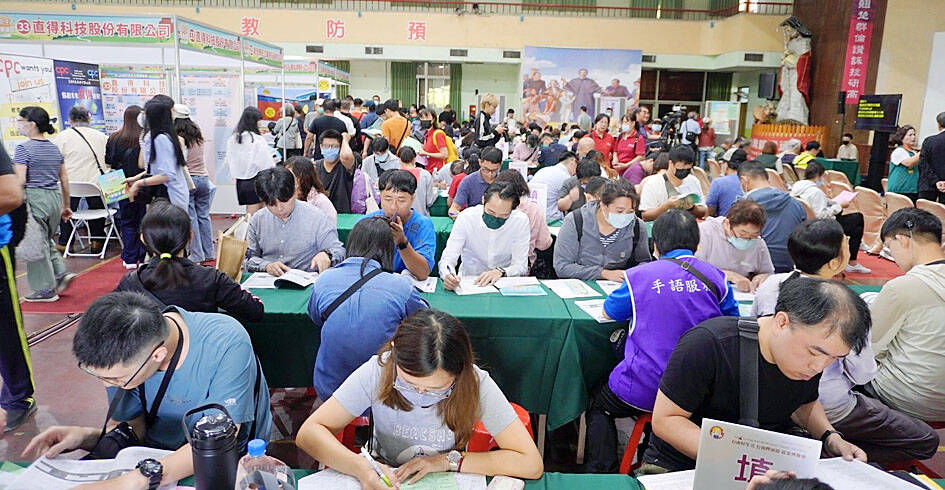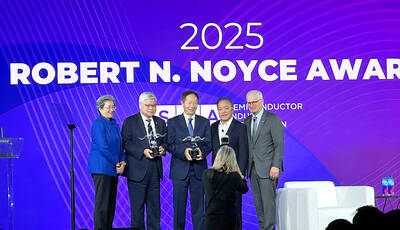Taiwan’s unemployment rate rose for a third consecutive month last month, reaching its highest level in a year as fresh graduates entered the labor market and the impact of US tariffs rippled through the economy, the Directorate-General of Budget, Accounting and Statistics (DGBAS) said yesterday.
The jobless rate climbed to 3.45 percent, up 0.05 percentage points from July, while the seasonally adjusted figure edged up 0.02 points to 3.35 percent.
“Despite the uptick, the labor market remains relatively stable and the unemployment rate is not particularly high,” DGBAS Census Department Deputy Director Tan Wen-ling (譚文玲) said in Taipei.

Photo courtesy of the Tainan City Government
However, signs of strain are emerging. The number of underemployed — those working fewer than 35 hours a week for economic reasons, but willing to work more — rose to 121,000, the highest this year, the agency’s report showed.
More companies have also turned to furloughs to cope with tariff-driven slowdowns, Tan said, noting that underemployment and furloughs are not reflected in the official unemployment rate.
Washington on Aug. 7 imposed a 20 percent tariff on Taiwanese goods, following earlier levies on autos, auto parts, and steel and aluminum.
Manufacturers of machine tools, auto parts, metals and bicycles are bearing the brunt, while technology firms tied to the global artificial intelligence hardware supply chain continue to benefit from robust demand.
Overall, the number of unemployed rose by 6,000 to 415,000, driven by layoffs from business closures or cutbacks, as well as more people entering the job market or leaving unsatisfactory positions, the DGBAS said.
Unemployment remains concentrated among the young and highly educated. University graduates face an unemployment rate of 4.68 percent, compared with 3.17 percent for those with a master’s degree and 3.03 percent for senior-high graduates.
Jobless rates peak among the 20 to 24 group at 12.08 percent and 8.71 percent for people aged 15 to 19, as they are struggling to find their first jobs, reflecting graduation-season pressures, the agency said.
By contrast, the jobless rate is 5.92 percent for those aged 25 to 29, and 3.26 percent for the 30-to-34 group.
The impact of graduation season typically fades this month, when unemployment declines after graduation pressures subside, Tan said.
However, if unemployment continues to rise, it could indicate that tariffs are starting to bite.
“We hope the impact will not worsen,” she said.

Shiina Ito has had fewer Chinese customers at her Tokyo jewelry shop since Beijing issued a travel warning in the wake of a diplomatic spat, but she said she was not concerned. A souring of Tokyo-Beijing relations this month, following remarks by Japanese Prime Minister Sanae Takaichi about Taiwan, has fueled concerns about the impact on the ritzy boutiques, noodle joints and hotels where holidaymakers spend their cash. However, businesses in Tokyo largely shrugged off any anxiety. “Since there are fewer Chinese customers, it’s become a bit easier for Japanese shoppers to visit, so our sales haven’t really dropped,” Ito

The number of Taiwanese working in the US rose to a record high of 137,000 last year, driven largely by Taiwan Semiconductor Manufacturing Co’s (TSMC, 台積電) rapid overseas expansion, according to government data released yesterday. A total of 666,000 Taiwanese nationals were employed abroad last year, an increase of 45,000 from 2023 and the highest level since the COVID-19 pandemic, data from the Directorate-General of Budget, Accounting and Statistics (DGBAS) showed. Overseas employment had steadily increased between 2009 and 2019, peaking at 739,000, before plunging to 319,000 in 2021 amid US-China trade tensions, global supply chain shifts, reshoring by Taiwanese companies and

Taiwan Semiconductor Manufacturing Co (TSMC) Chairman C.C. Wei (魏哲家) and the company’s former chairman, Mark Liu (劉德音), both received the Robert N. Noyce Award -- the semiconductor industry’s highest honor -- in San Jose, California, on Thursday (local time). Speaking at the award event, Liu, who retired last year, expressed gratitude to his wife, his dissertation advisor at the University of California, Berkeley, his supervisors at AT&T Bell Laboratories -- where he worked on optical fiber communication systems before joining TSMC, TSMC partners, and industry colleagues. Liu said that working alongside TSMC

TECHNOLOGY DAY: The Taiwanese firm is also setting up a joint venture with Alphabet Inc on robots and plans to establish a firm in Japan to produce Model A EVs Manufacturing giant Hon Hai Precision Industry Co (鴻海精密) yesterday announced a collaboration with ChatGPT developer OpenAI to build next-generation artificial intelligence (AI) infrastructure and strengthen its local supply chain in the US to accelerate the deployment of advanced AI systems. Building such an infrastructure in the US is crucial for strengthening local supply chains and supporting the US in maintaining its leading position in the AI domain, Hon Hai said in a statement. Through the collaboration, OpenAI would share its insights into emerging hardware needs in the AI industry with Hon Hai to support the company’s design and development work, as well